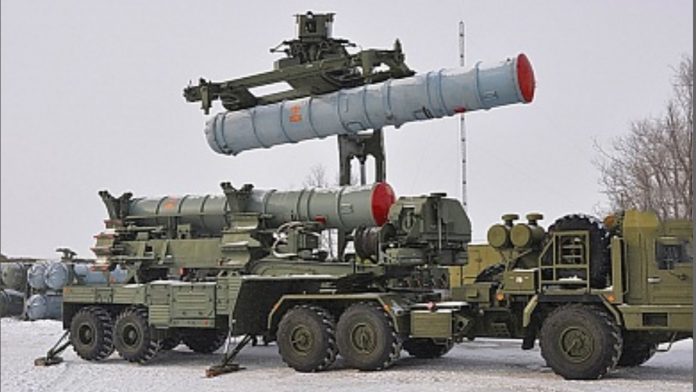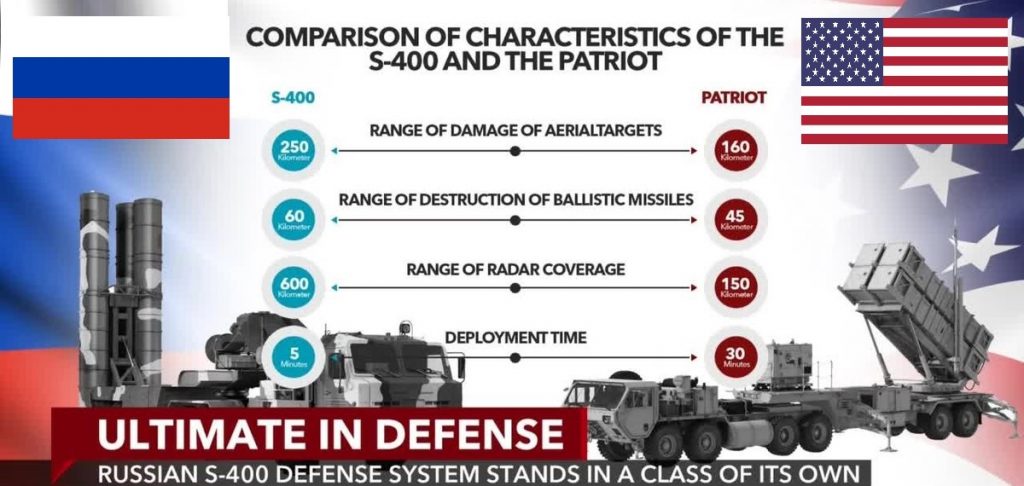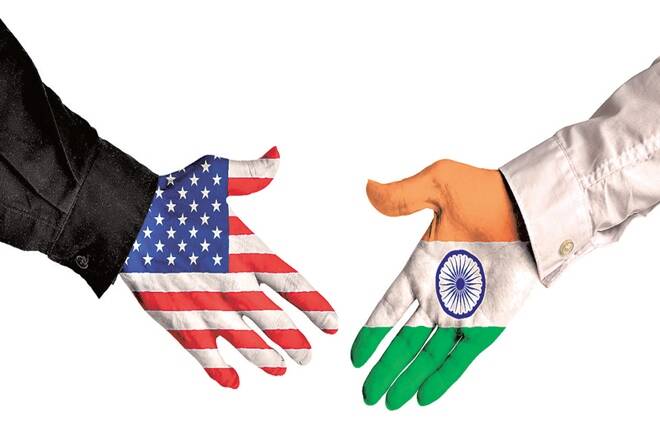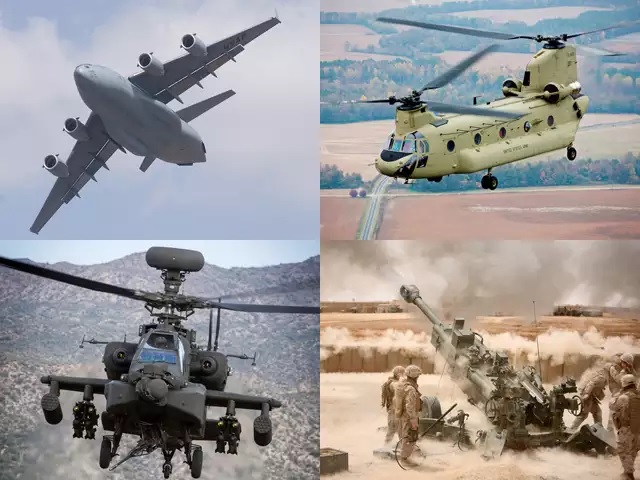
- US India share values of democracy, free trade, liberal entrepreneurship, human rights, peaceful change of elected governments, fight against terrorism.
- American security and defense needs are coinciding with India’s concerns. India is a direct victim of Jihad sponsored by Pakistan, ISIS, Al Qaeda, while America is fighting the same elements from South Asia to the Middle East and across the world.
- The Rise of China and threat to freedom of navigation, usurping land, air space, water, forcing drought on riparian states, debt trap diplomacy and change of borders unilaterally, have made both India and America see the world in the same light in defence of democracy.
- The cutting-edge S-400 system is superior to the patriot air defence system in all aspects and India has to cater to its own pressing needs.
– Long standing US-India ties and growing US-India defence deals worth billions of dollars cannot be risked over a strategically important deal with Russia. - It is for India to decide what weapons it needs and how it safeguards its 1.3 Billion people. The US should not see India from its own vision of Russia but be sympathetic to its own needs.
Democracy, free trade, liberal entrepreneurship, human rights, peaceful change of elected governments, fight against terrorism, coalition against state sponsored terror, hawala funding, rise of Indians in America have made India-US relations strong at all levels – bilateral, regional and at global level. Given New Delhi’s good rapport with successive US governments from Bill Clinton, George W Bush, Obama to President Donald Trump and the success of Indian origin Kamala Harris as Vice President – elect now, the relations have become real, pragmatic and natural.
Meanwhile strategically American security and defense needs are coinciding with India’s concerns. India is a direct victim of Jihad sponsored by Pakistan, ISIS, Al Qaeda, Taliban, and America too is fighting the same elements from South Asia to the Middle East and across the world. The Rise of China and threat to freedom of navigation, usurping land, air space, water, forcing drought on riparian states, debt trap diplomacy and change of borders unilaterally, standoff at Ladakh have made both India and America see the world in the same light in defence of democracy.
During the Cold War, India had strategic military and defense partnership with Russia. India was the second largest market for the Russian defense industry. In 2017, approximately 68% of the Indian military hardware was imported from Russia, making Russia the chief supplier of defense equipment. India and Russia have deepened their ‘Make in India’ defense manufacturing cooperation by signing agreements for the construction of naval frigates, KA-226T twin-engine utility helicopters (JV to make 60 in Russia and 140 in India), Brahmos cruise missile (JV with 50.5% India and 49.5% Russia). Between 2013 and 2018, Russia accounted for 62% of arms sales to India, down from 79% between 2008 and 2012.
As tensions between India and China were increasing after the Doklam incident in 2017, Chinese Army was amassing its troops on India’s borders. In October 2018, India signed its biggest arms deal worth $5.43 billion to purchase five regiments of the S-400. China already has the S-400 air defence system. The cutting-edge S-400 system can detect and shoot down targets including ballistic missiles, enemy jets and drones up to 600 kilometers (373 miles) away, at altitudes of between 10 meters and 27 km (17 mi). Against the speed of 5,000 km per hour (3,106 mi per hour) of the US Patriot air defense system, Russian S-400 has a maximum speed of 17,000 km per hour (10,563 mi per hour).

S-400 can pick-up over 300 aerial objects and can even prioritize them as per threat perception, and destroy at least 30. The S-400 system, if deployed, along the border will provide India an edge of 600kms radar coverage with the option of shooting down incoming aircraft from 400kms from its territory. While China had received the first batch of the S-400 missiles in 2018, Russia delivered the second batch of the system to China in December 2019, amid rising tensions with the US. So India needs S-400 on an urgent basis to defend itself from China’s expansionism.
However the US federal law countering America’s adversaries through the Sanction Act imposes sanctions against countries that engage in defense and intelligence transactions with Iran, North Korea, and Russia. Last month, the US Assistant Secretary of State Clarke Cooper once again cautioned India against going ahead with the procurement of the S-400 from Russia. As tensions with China threatened to boil over, the India-US relations were at risk due to this deal. It is anyone’s knowledge that the US does not have a comparative air defence system to the S-400. The US president has a provision to provide a waiver, and it is highly likely that India will receive it seeing the threat perception in the region.
Importantly, it is to be noted that the Congressional Research Service (CRS) is an independent and bipartisan research wing of the US Congress. Its reports are neither an official report of the US Congress nor do they reflect the view of Congressmen. They are prepared by independent experts for the lawmakers to take informed decisions. There are few people in India and abroad who are trying to misuse and misrepresent the India US Strategic Ties through such reports.
Long Standing US-India ties

One has to understand that America has four ‘foundational agreements’ that it signs with its defence partners. The Pentagon describes the agreements as “routine instruments that the U.S. uses to promote military cooperation with partner-nations”. The first of the four agreements, the General Security Of Military Information Agreement (GSOMIA), was signed by India and the U.S. in 2002. The agreement enables the sharing of military intelligence between the two countries and requires each country to protect the others’ classified information.
The second agreement, the Logistics Exchange Memorandum of Agreement (LEMOA), was signed by the two countries on 29 August 2016. The LEMOA permits the military of either country to use the others’ bases for re-supplying or carrying out repairs. The agreement does not make the provision of logistical support binding on either country, and requires individual clearance for each request. The third agreement, Communications Compatibility and Security Agreement (COMCASA) was signed during the inaugural 2+2 dialogue in September 2018. It is an India-specific variant of Communications and Information Security Memorandum of Agreement (CISMOA) that enables the two countries to share secure communication and exchange information on approved equipment during bilateral and multinational training exercises and operations.
The fourth agreement, the Basic Exchange and Cooperation Agreement (BECA), signed in 2020, permits the exchange of unclassified and controlled unclassified geospatial products, topographical, nautical, and aeronautical data, products and services between India and the US National Geospatial-Intelligence Agency (NGA).
As part of America’s policies to counter China, one of the American administration policies is to make India as one of the major defence partners for which it is in talks with Indian representatives to sell highly technologically advanced predator drones. India has floated a tender to buy 100 multi role fighter aircraft in the Indian MRCA competition (also called Mother of all defence deals), worth around US$15 billion under Narendra Modi’s Make in India initiative. Although the deal is yet to be finalised in 2018, Trump’s administration was already pushing for sales of advanced F-16 jet fighters, and F/A-18 Super Hornet.
In June 2015, US defence secretary Ashton Carter visited India and became the first American defence secretary to visit an Indian military command. In December of the same year, Manohar Parrikar became the first Indian defence minister to visit the US Pacific Command. In January 2017, Peter Lavoy, Senior Director for South Asian Affairs at the U.S. National Security Council, declared that the partnership between India and the United States “I can tell you quite definitively that due to our partnerships, several terrorism plots were foiled. Indian lives and American lives were saved because of this partnership.”
In late September 2001, President Bush lifted sanctions imposed under the terms of the 1994 Nuclear Proliferation Prevention Act following India’s nuclear tests in May 1998. On 2 March 2006 India and the United States signed the Indo-US Nuclear Pact on co-operation in the civilian nuclear field.
Growing US-India Defence deals

Some of the important defence deals of India USA are India and the US have signed a $930 million agreement for 6 Apache Helicopters for Indian Army. The contract was made in the year 2015 by the Indian Air Force for 22 Apache helicopters. Out of 22 helicopters, 17 have already been delivered to India and the rest will be delivered in the year 2023. These helicopters will be deployed on the Rajasthan border with Pakistan on western sector. In 2018, after the dialogue between India and the United States in New Delhi, the South Block gave a nod to the Indian Navy to pursue the acquisition of 24 Sikorsky MH-60R helicopters. The contract was finally sealed in February 2020, during President Trump’s visit to India.
The $2.6 billion deal between India and the US includes helicopter, communication systems, weapons systems, eight anti-surface Hellfire Missiles which can be used to hit at ships, MK 54 Lightweight Torpedoes, 50 cannons and precision rocket systems. The Government of India has signed a $ 190 million deal with the US Government to procure two self-protection suites (SPS). The deal was signed during President Trump’s visit to India in February 2020. These suites will be retrofitted on the two custom-built Boeing-777 aircraft earlier acquired for long-haul VVIP travel. The US and the Indian Government signed a $ 2-3 billion deal for the Guardian drones. The US Government has cleared the sale of 22 predator Guardian drones to India. The drones are manufactured by General Atomics. India signed a deal of $1.0210 billion with the US to obtain 13 MK45 Naval guns and related equipment.
The MK-45 Gun System will help India to conduct anti-surface warfare and anti-air defence missions while enhancing its interoperability with the U.S. and other allied forces. India will use the enhanced capability as a deterrent to regional threats and strengthen the defence system. The contractor of India-US defence deal is BAE Systems Land and Armaments, Minneapolis, Minnesota with gun manufacturing in Louisville, Kentucky.
India’s interests are paramount
Conclusion
At last one can conclude that India America defense relations are strong, vibrant and natural. The relations are based on real time current geopolitical scenarios. India needs Russia and also the US for its survival and strategic interest. The US seems to have sensed an opportunity in the India-China border standoff and wants to further raise its profile in the region to save democracy. It’s being seen as a signal to China that Washington considers Democratic Delhi a close military ally.
Given the scenario, America has to waive the S-400 sale to India both in order to serve its ties with India and keeping in mind India’s own defense viability. Further, India is a huge customer for American arms and ammunitions. India will also be mindful of its relations with Russia as most of the weapons earlier were brought from them. India has to be free to consider its own military requirements when it is at a standoff with an expansionist force at its border. Its defence arsenal should be its own prerogative.
Finally, it is for India to decide what weapons it needs and how it safeguards its 1.3 Billion people. On the other hand it respects America’s sentiments on Russia but the nation and its military has to run and be trusted by its own citizens. So the US should not see India from its own vision of Russia but be sympathetic to its needs. Ultimately the aim of India is peace and love for the world rather than domination and repression of expansionist forces which the US and the world are gradually comprehending.
M.AM.PhiL/(PhD SNU South Korea)
